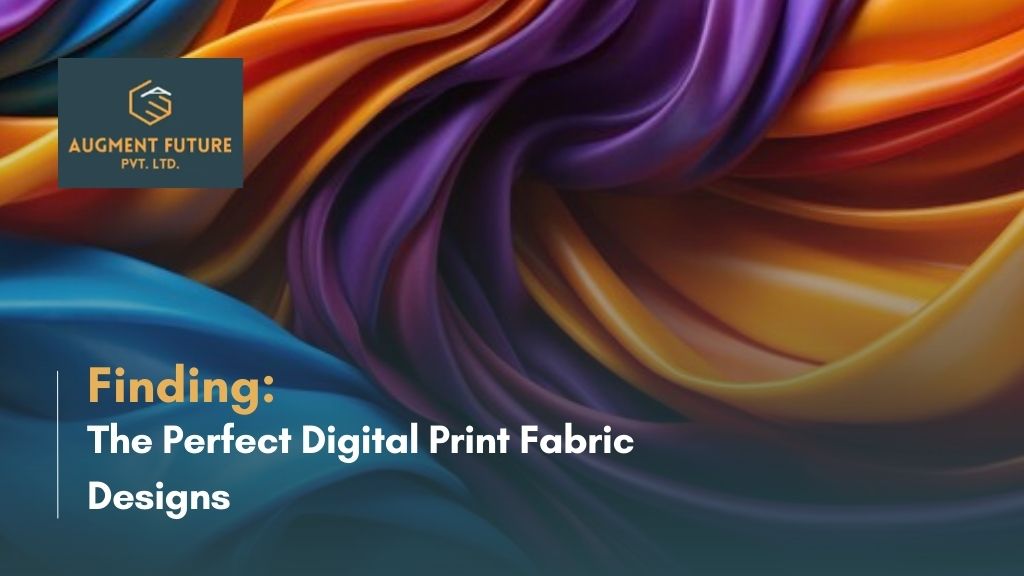In the rapidly evolving world of textile printing, digital fabric printing has emerged as a cutting-edge technology with its ability to produce vibrant and intricate designs on a wide range of fabrics. But with so many fabric materials available, selecting the right one for digital printing can be a daunting task. In this article, we will decode the art of digital fabric printing and explore the best fabric materials for this innovative technique.
Understanding Digital Fabric Printing
Digital fabric printing involves the direct application of ink onto fabric using specialized digital printers. Unlike traditional printing methods, digital fabric printing offers greater design flexibility, faster production times, and the possibility of printing on demand. Let’s delve into the basics of this fascinating technique.
When it comes to digital fabric printing, the possibilities are endless. Designers can create intricate patterns, vibrant colours, and photorealistic images with ease. This technology opens up a whole new world of creativity in the textile industry, allowing for custom designs and small print runs without the constraints of traditional printing methods.
The Basics of Digital Fabric Printing
At its core, digital fabric printing relies on computerized files that contain the desired design. These files are then converted into printable patterns using specialized software. Once the design is ready, it is transferred to the digital printer, which applies the ink onto the fabric using advanced print heads.
One of the key advantages of digital fabric printing is its eco-friendly nature. Unlike traditional printing processes that can generate a significant amount of waste, digital printing produces minimal waste by only using the necessary amount of ink for each design. This not only reduces environmental impact but also allows for more sustainable production practices in the textile industry.
Key Factors in Digital Fabric Printing
Several factors contribute to the success of digital fabric printing. First and foremost is the ink formulation. Pigment and dye-based inks are commonly used, each offering its own unique properties and colourfastness. The resolution and dot placement of the print heads also play a crucial role in achieving sharp and detailed prints. Additionally, the pre-and post-treatment processes, such as fabric preparation and fixation, are vital for ensuring colour vibrancy and durability.
Another important factor to consider in digital fabric printing is the type of fabric being used. Different fabrics react differently to the printing process, affecting the final outcome of the design. Factors such as fabric composition, weight, and weave can all impact how the ink interacts with the fabric and the overall quality of the print. Understanding these fabric characteristics is essential for achieving the desired results in digital fabric printing.
You May Also Like To Read: Print Your Passion: Exploring the World of Digital Fabric Printing
Different Types of Fabric Materials
When it comes to selecting fabric materials for digital printing, understanding the characteristics of different types is essential. Let’s explore the two main categories: natural fabrics and synthetic fabrics.
Natural Fabrics and Digital Printing
Natural fabrics, such as cotton, silk, and linen, are popular choices for digital printing. They offer excellent breathability, comfort, and versatility. Cotton, in particular, is widely favoured for its absorbency, which allows for excellent colour saturation in digital prints. Silk, on the other hand, imparts a luxurious sheen and drape to the printed designs. Linen, with its unique texture, adds a rustic appeal to digital fabric prints.
Moreover, natural fabrics are known for their sustainability and biodegradability, making them environmentally friendly choices for digital printing projects. Cotton, being a natural fibre, is renewable and biodegradable, reducing the environmental impact of fabric production. Silk, although a luxury fabric, is also biodegradable and can be recycled into various products. Linen, made from the flax plant, requires minimal water and pesticides to grow, further enhancing its eco-friendly profile.
Synthetic Fabrics and Digital Printing
Synthetic fabrics, including polyester, nylon, and spandex, have gained prominence in digital fabric printing due to their durability and wrinkle resistance. Polyester, in particular, is a preferred choice for its vibrant colour reproduction and fast drying time. Nylon offers excellent tensile strength, making it ideal for sportswear and activewear. The stretch and elasticity of spandex make it a popular choice for garments that require flexibility and comfort.
Additionally, synthetic fabrics are known for their versatility in terms of performance features. Polyester, a synthetic polymer, is resistant to shrinking and stretching, making it a durable choice for various applications. Nylon, originally developed as a silk substitute, is lightweight yet strong, making it suitable for a wide range of clothing items. Spandex, known for its exceptional elasticity, is often blended with other fabrics to add stretch and shape retention to garments.
You May Also Like To Read: The Science of Color Matching: Creating Harmonious Designs with Precision
Evaluating Fabric Materials for Digital Printing
When it comes to choosing the best fabric material for digital printing, several factors come into play. Let’s explore two key considerations: durability and cost-effectiveness.
Aside from durability and cost-effectiveness, it’s also crucial to consider the environmental impact of the fabric materials used for digital printing. Sustainable options like organic cotton, bamboo, or recycled polyester are gaining popularity due to their eco-friendly nature. These materials not only offer high-quality print results but also reduce the carbon footprint associated with textile production.
Durability and Print Quality
The durability of a fabric is of utmost importance, especially for items that undergo frequent washing or heavy use. Polyester and synthetic blends are known for their excellent wash-fastness and resistance to fading, making them suitable for digital print fabric. However, natural fabrics, such as cotton and linen, may require extra care to maintain their vibrant colours over time.
In addition to durability, the choice of fabric material can also impact the overall feel and texture of the printed design. Fabrics like satin and silk can enhance the visual appeal of digital prints, adding a luxurious touch to the finished product. On the other hand, canvas and denim offer a more rugged and textured surface, perfect for achieving a vintage or casual look.
Cost-effectiveness of Different Fabrics
Cost-effectiveness is another vital factor to consider. Polyester fabrics tend to be more affordable than natural fabrics like silk and linen. Elasticity and stretch, common in synthetic fabrics, can also help minimize fabric waste during garment production, thereby reducing overall costs.
Moreover, the versatility of certain fabric materials should not be overlooked when evaluating cost-effectiveness. Fabrics that can be used for multiple purposes, such as both apparel and home decor, offer a higher return on investment. This versatility allows for greater flexibility in design choices and target markets, ultimately maximizing the value of the chosen fabric material for digital printing.
The Role of Fabric Weave in Digital Printing
Another important aspect to consider is the fabric weave, which can significantly influence the final print quality. Let’s explore the impact of tight and loose weaves on digital fabric printing.
When it comes to digital printing on fabric, the weave of the material plays a crucial role in determining the overall outcome of the printed design. Apart from the type of fabric itself, whether it’s cotton, polyester, silk, or any other material, the weave can make a substantial difference in how the colours appear and how sharp the details turn out.
Tight Weave vs Loose Weave Fabrics
Tight weave fabrics, such as poplin and twill, have a denser construction with tightly packed yarns. They provide a smooth, even surface for digital printing, resulting in crisp and defined prints. On the other hand, loose weave fabrics, like gauze and muslin, have a more open construction with loosely spaced yarns. While they offer a softer and drapier feel, the looser weave can sometimes lead to less precise prints.
Additionally, the choice between a tight or loose weave fabric can also impact the durability of the printed design. Tight weaves tend to hold the ink better and prevent it from bleeding, ensuring a longer-lasting print. In contrast, loose weaves may not retain the ink as effectively and could result in a slightly faded look over time, especially after multiple washes.
Impact of Weave on Print Clarity
For intricate designs and fine details, a tight weave fabric is recommended to ensure clarity and sharpness in the printed image. The close-knit structure of tight weaves provides a stable base for intricate patterns, allowing the printer to capture every detail with precision. However, for designs that require a softer, textured look, a loose weave fabric can add depth and visual interest, creating a more artistic and organic feel to the final print.
It’s essential for designers and manufacturers to carefully consider the weave of the fabric when planning for digital printing, as it can make a significant difference in the overall quality and appearance of the final product. By understanding how tight and loose weaves influence digital prints, one can make informed decisions to achieve the desired outcome for their fabric designs.
You May Also Like To Read: Elevate Your Style with Printed Shirting Fabrics: A Guide from Augment Future Pvt Ltd
Environmental Considerations in Digital Fabric Printing
In today’s environmentally conscious world, sustainability in fabric printing has become a significant concern. Let’s explore eco-friendly fabric choices and sustainable practices in digital fabric printing.
Eco-Friendly Fabric Choices
Choosing eco-friendly fabric materials, such as organic cotton, hemp, or bamboo, promotes sustainable practices in digital fabric printing. These fabrics are produced using methods that minimize environmental impact, such as reducing chemical usage and conserving water.
Sustainability in Digital Fabric Printing
To further promote sustainability, digital fabric printers can adopt eco-friendly ink formulations and implement recycling programs for waste materials. Additionally, embracing on-demand printing can help reduce overproduction and minimize textile waste.
In conclusion, digital fabric printing offers endless possibilities for creating unique and vibrant designs on various fabric materials. By considering factors such as durability, cost-effectiveness, fabric weave, and environmental impact, you can select the best fabric for your digital printing needs. Whether you choose natural fabrics like cotton or synthetic materials like polyester, decoding the art of digital fabric printing opens up a world of creativity and innovation.
Explore Our Services: Digital Fashion Printing, Home Furnishing Printing, Customized Printing, Bulk Printing, Colour Matching, Expert Design Assistance.
Explore Our Fabric Offerings: Rayon Fabric, Georgette Fabric, Digital Print Cotton Fabric, Cotton Fabric Floral Print, Cotton Cambric Fabric, Mulmul Fabric, Printed Georgette Fabric, White Embroidered Fabric, & more.






